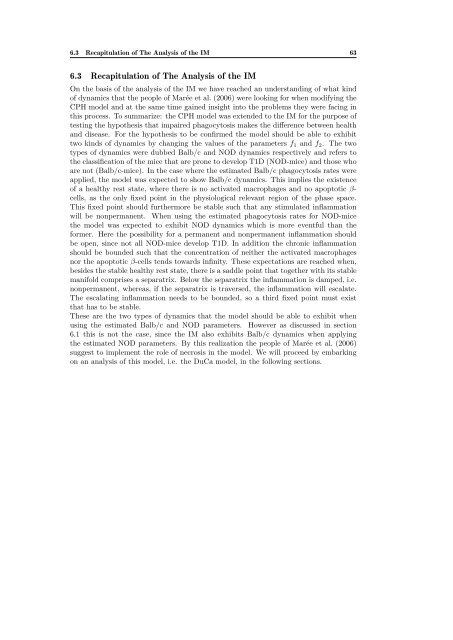nr. 477 - 2011 - Institut for Natur, Systemer og Modeller (NSM)
nr. 477 - 2011 - Institut for Natur, Systemer og Modeller (NSM)
nr. 477 - 2011 - Institut for Natur, Systemer og Modeller (NSM)
Create successful ePaper yourself
Turn your PDF publications into a flip-book with our unique Google optimized e-Paper software.
6.3 Recapitulation of The Analysis of the IM 63<br />
6.3 Recapitulation of The Analysis of the IM<br />
On the basis of the analysis of the IM we have reached an understanding of what kind<br />
of dynamics that the people of Marée et al. (2006) were looking <strong>for</strong> when modifying the<br />
CPH model and at the same time gained insight into the problems they were facing in<br />
this process. To summarize: the CPH model was extended to the IM <strong>for</strong> the purpose of<br />
testing the hypothesis that impaired phagocytosis makes the difference between health<br />
and disease. For the hypothesis to be confirmed the model should be able to exhibit<br />
two kinds of dynamics by changing the values of the parameters f1 and f2. The two<br />
types of dynamics were dubbed Balb/c and NOD dynamics respectively and refers to<br />
the classification of the mice that are prone to develop T1D (NOD-mice) and those who<br />
are not (Balb/c-mice). In the case where the estimated Balb/c phagocytosis rates were<br />
applied, the model was expected to show Balb/c dynamics. This implies the existence<br />
of a healthy rest state, where there is no activated macrophages and no apoptotic βcells,<br />
as the only fixed point in the physiol<strong>og</strong>ical relevant region of the phase space.<br />
This fixed point should furthermore be stable such that any stimulated inflammation<br />
will be nonpermanent. When using the estimated phagocytosis rates <strong>for</strong> NOD-mice<br />
the model was expected to exhibit NOD dynamics which is more eventful than the<br />
<strong>for</strong>mer. Here the possibility <strong>for</strong> a permanent and nonpermanent inflammation should<br />
be open, since not all NOD-mice develop T1D. In addition the chronic inflammation<br />
should be bounded such that the concentration of neither the activated macrophages<br />
nor the apoptotic β-cells tends towards infinity. These expectations are reached when,<br />
besides the stable healthy rest state, there is a saddle point that t<strong>og</strong>ether with its stable<br />
manifold comprises a separatrix. Below the separatrix the inflammation is damped, i.e.<br />
nonpermanent, whereas, if the separatrix is traversed, the inflammation will escalate.<br />
The escalating inflammation needs to be bounded, so a third fixed point must exist<br />
that has to be stable.<br />
These are the two types of dynamics that the model should be able to exhibit when<br />
using the estimated Balb/c and NOD parameters. However as discussed in section<br />
6.1 this is not the case, since the IM also exhibits Balb/c dynamics when applying<br />
the estimated NOD parameters. By this realization the people of Marée et al. (2006)<br />
suggest to implement the role of necrosis in the model. We will proceed by embarking<br />
on an analysis of this model, i.e. the DuCa model, in the following sections.
















